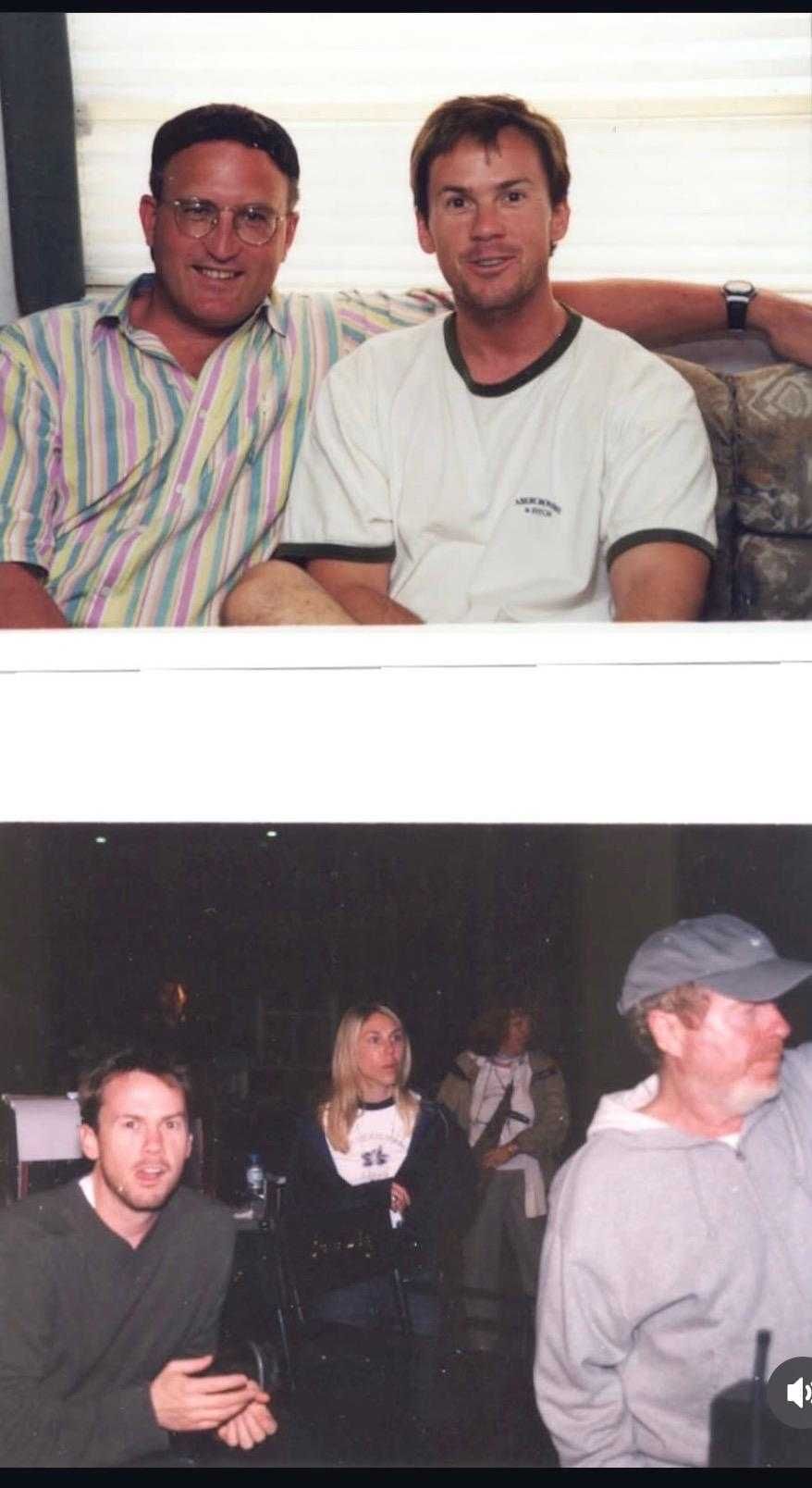Screenwriter Ken Nolan was playing Wordle when he heard the news that one of his all-time favorite directors/writers, Quentin Tarantino, had dropped a two-part list of his 20 favorite films of the 21st century.
I know this because we've been on a Wordle thread for five years. "Take your turns," he urged us, when our other pal said, "Hey Ken? Did you know Tarantino just named Black Hawk Down the number one film of the 21st century?"
The thing is? Nolan wrote that film. At first he thought it was a gag. "No, really," our friend reiterated. "Here!" He then dropped in a Deadline article, followed by the news in Variety. Too many great sources to deny. Once Nolan truly believed it, he texted us, "God that feels good and almost unreal."
Original trailer for the film Black Hawk Down. www.youtube.com, Scott Free Productions, Jerry Bruckheimer Films
According to Jordan Ruimy's piece on World of Reel, Tarantino had been "inspired by The Big Picture Podcast’s 25 best films of the century list." Tarantino decided to "guest on The Bret Easton Ellis Podcast and make his own list. The filmmaker 'grabbed a pen,' and 'started writing titles.' He's come up with his own 20 best films of the 21st century; only one film allowed per director."
The movies he selected are diverse, to say the least. While there are quite a few gory horror films (because of course) like Cabin Fever and the adorably cheeky Shaun of the Dead, Tarantino included some surprising picks as well. Steven Spielberg's West Side Story came in at number 20, Richard Linklater's School of Rock at 14. Yes, of course Jackass: The Movie grabbed a slot, as did Toy Story 3.
But number one was unequivocally Black Hawk Down, based on the book by Mark Bowden and directed by Ridley Scott. Of that, Tarantino said in part, "I think it’s a masterwork, and one of the things I love so much about it is […] this is the only movie that actually goes completely for an 'Apocalypse Now’ sense of purpose and visual effect and feeling, and I think it achieves it. It keeps up the intensity for 2 hours 45 minutes, or whatever it is, and I watched it again recently, my heart was going through the entire runtime of the movie; it had me and never let me go, and I hadn’t seen it in a while. The feat of direction is beyond extraordinary."
Watching Nolan learn of this extraordinary compliment was fun to witness in real time, since Nolan is so incredibly talented and deserving. So we asked him to share what it was like to write that screenplay and his thoughts on having such high honor accolades from a legend.
 Writer Ken Nolan poses with actor William Fichtner. Ken poses on set.Photo Credit: Ken Nolan
Writer Ken Nolan poses with actor William Fichtner. Ken poses on set.Photo Credit: Ken Nolan
Upworthy: How did you land this project?
Nolan: "It's a long story, but I had sold a few spec scripts by 1998, and the executives at Bruckheimer, Chad Oman and Mike Stenson, were aware of me. They asked if I would read Mark Bowden's galleys for his upcoming book Black Hawk Down.
I didn’t know what those three words meant, 'Black Hawk Down.' It might as well have been 'Moose Donkey Teacup.' They didn’t go together. I sat on my couch at home and started reading. Hours later, I got up, all sweaty, to go get a drink of water. I realized I hadn’t moved in four hours. I had simply been inhaling Mark Bowden’s book, and couldn't put it down. I think I finished it that night or the next day. I knew I had to get this job. I would wash Jerry Bruckheimer’s car to get it. Whatever! I was born to write this movie."
Have you kept in touch with any of the cast and crew?
"I've kept in touch with cast members Eric Bana, Kim Coates, Bill Fichtner and Orlando Bloom on and off through the years (to name a few). Executives Chad Oman, Mike Stenson, and of course Mr. Jerry Bruckheimer (who hired me again!). I said 'hi' once after a Broadway show to Jeremy Piven, who I think didn't remember me. And then at another Broadway show I tried to remind Ewan McGregor that I was the writer he kept asking for cigarettes (I don't smoke) and he looked at me as if I had just arrived from a distant and vaguely annoying galaxy.
Mark Bowden has been my mentor ever since, always telling me when I complain about this or that to 'Be a professional.' Very calm and sage advice. Ridley Scott and I worked together again on The Company, which he was going to direct as a feature, but it fell apart and instead became a mini-series. I learned more in the four months on set with Ridley than the previous 34 years of my life (at that time) watching and studying movies."
 Ken Nolan poses with writer Mark Bowden. Ken and Ridley Scott on set.Photo Credit: Ken Nolan
Ken Nolan poses with writer Mark Bowden. Ken and Ridley Scott on set.Photo Credit: Ken Nolan
What were your first thoughts upon hearing Tarantino say the movie was his favorite of this century?
"Well, it blew me away. It was a better feeling (how would I know, but I'm guessing), than winning an Academy Award. For a few reasons. One, he is one of my heroes, and two, this is his opinion. You can't take that away and say things like, 'Oh, they gave the film that award because they overlooked the director's last three movies and the Academy wanted to honor him or her.' It's his opinion. And what made me feel amazing was — this isn't just some guy off the street, or even a critic. Quentin Tarantino is a walking film encyclopedia. And not just of Criterion Collection movies or AFI movies — he's a walking video store of crap and junk and B movies and Z movies and everything there is. He loves them all. Loves movies. So this felt especially amazing to me. This man knows movies as well as Scorsese does. He may even know movies Scorsese has never heard of. He may know more movies than Spielberg.
The feeling of being recognized is as gratifying as it gets. Also because I distinctly remember Ridley saying of the Best Picture nominees that year at the Oscars (Mark Bowden took me as his guest to the Oscars that year), 'We should be up there, mate.' Meaning we should be nominated. We weren't. It confused me at the time. I knew the movie was great. Wasn't it? Was I wrong? No. I wasn't wrong, it turns out. Quentin Tarantino says so. So there."
What are your favorite QT movies?
"His best movie to me is Once Upon a Time in Hollywood. But I have to give you my Quentin Tarantino background. In 1992, I was trying to make it as a screenwriter, but scraping by check to check as an assistant. I had read a review of this film called Reservoir Dogs. It was a rave review from someone, I can't remember. I saw it was going to play at ONE THEATER in Los Angeles. Way across town. I think it was the Vista. I got in my Honda Civic right after work on that Friday and went alone to the theater, running up knowing it would be sold out and I'd be out of luck. I was an hour early. 'Was there a long line for the last show?' I said in a breathless hiss to the guy behind the ticket counter. 'No,' he said. I realized I was the only person 'in line.' It stayed that way. I'm pretty sure I saw the movie with about ten other people.
 Quentin Tarantino at the Oscars. Giphy Deal With It GIF by The Academy Awards
Quentin Tarantino at the Oscars. Giphy Deal With It GIF by The Academy Awards
The movie was great. But it wasn't until two years later when my girlfriend at the time said, 'Hey, my friend Bumble Ward is the publicist for that director you like, Quentin. She says you can help work a screening and then we can see the movie for free. Wanna pass out flyers before?' They might have been audience cards to fill out or something. Anyway, I said, 'Hell yes!' We saw the movie, and something in my life shifted on its axis. This was a young filmmaker who made something no one had ever seen before. And I knew someone who knew his publicist! That meant I could do what he was doing. I could write scripts.
So I sold my first script in 1994. And then, nothing.
No one wanted my second script — a disaster script called San Andreas. I was almost out of money from that first script sale, and I remember I would go to 3rd Street Promenade from my bachelor apartment (no bedroom, no kitchen), and read magazines and books and drink coffee, then go home and write. I read an interview with Tarantino that day and he said, 'I consider myself a court reporter, just writing down what my characters say.' I stood up and said, 'That's what I'm going to do, right now.' I pedaled my bike home (my Honda Civic had been stolen a few weeks earlier), and I wrote a script in 11 days. It sold and I was on my way to being a professional writer. All because of that article."
Any other films on his list with which you agree?
"I agree with all of them, but especially Zodiac and Mad Max: Fury Road. Zodiac, like Black Hawk Down, needs a few decades to age and be revisited. The script by Jamie Vanderbilt was really inspiring to me as a writer, too. The great thing about Tarantino is he'll put Unstoppable on the list, which I never would have thought of. I saw it recently and was practically laughing at the incredible amount of extras, cars, stunts, and money spent on this movie. I said to myself, 'This is the very last of these kinds of movies. No one will spend money like this on a non super-hero movie.' I felt the same way about Munich. I said, 'This is the last of one of these Day of the Jackal-esque or Black Sunday kind of action, hop-around-Europe-locations, multi-ethnic, multi-cultural cast movies there will ever be. You cannot make these movies anymore. There will not be a Bridge Too Far again."





 TikTok · Ale
TikTok · Ale
 Autumn created this piece when she was just 5 years old.Autumn de Forest
Autumn created this piece when she was just 5 years old.Autumn de Forest  Autumn de Forest paints Autumn de Forest
Autumn de Forest paints Autumn de Forest  An Autumn de Forest paintingAutumn de Forest
An Autumn de Forest paintingAutumn de Forest 
 Autumn de Forest stands with the Pope who looks at one of her paintings Autumn de Forest
Autumn de Forest stands with the Pope who looks at one of her paintings Autumn de Forest 
 Writer Ken Nolan poses with actor William Fichtner. Ken poses on set.Photo Credit: Ken Nolan
Writer Ken Nolan poses with actor William Fichtner. Ken poses on set.Photo Credit: Ken Nolan Ken Nolan poses with writer Mark Bowden. Ken and Ridley Scott on set.Photo Credit: Ken Nolan
Ken Nolan poses with writer Mark Bowden. Ken and Ridley Scott on set.Photo Credit: Ken Nolan Quentin Tarantino at the Oscars.
Quentin Tarantino at the Oscars. 

 Text Me GIF by OKCrealtor
Text Me GIF by OKCrealtor  GIF by mrjonjon
GIF by mrjonjon  Hold On No GIF by Originals
Hold On No GIF by Originals  Threw it on the ground GIF
Threw it on the ground GIF 
 Costco price tag decoder.Image via Reddit/Olshansk
Costco price tag decoder.Image via Reddit/Olshansk